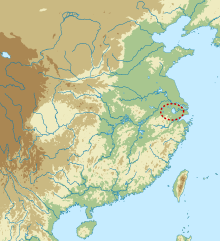
Back Cultura de Majiabang Catalan Majiabang-Kultur German Kebudayaan Majiabang ID Cultura di Majiabang Italian 馬家浜文化 Japanese 마자방 문화 Korean Majiabangkulturen NB Văn hóa Mã Gia Banh Vietnamese 馬家浜文化 WUU 马家浜文化 Chinese
 | |||||||||
| Alternative names | Ma-chia-pang culture | ||||||||
|---|---|---|---|---|---|---|---|---|---|
| Geographical range | Zhejiang, China | ||||||||
| Period | Neolithic China | ||||||||
| Dates | 5000–3350 BC | ||||||||
| Major sites | Weidun Site | ||||||||
| Followed by | Liangzhu culture | ||||||||
| Chinese name | |||||||||
| Traditional Chinese | 馬家浜文化 | ||||||||
| Simplified Chinese | 马家浜文化 | ||||||||
| |||||||||
The Majiabang culture, formerly also written Ma-chia-pang,[1] was a Neolithic culture that occupied the Yangtze River Delta, primarily around Lake Tai west of modern Shanghai[a] and north of Hangzhou Bay. The culture spread throughout southern Jiangsu and Zhejiang north of Hangzhou Bay from around 5000 BC to 3300 BC,[2] coexisting with the Hemudu culture in Zhejiang south of the bay.[3] The later part of the period is now considered a separate cultural phase, referred to as the Songze culture.[4] The Majiabang and Songze cultures were succeeded in their area by the Liangzhu culture.
Based on their archaeological findings, archaeologists have theorised that the Majiabang culture is the origin of the early fishing, hunting and gathering economy in China, and that the rice-dominant system of agriculture was developed by people living in this period.[5]
Majiabang people cultivated rice. At Caoxieshan and Chuodun, sites of the Majiabang culture, archaeologists excavated paddy fields, indicating the centrality of rice to the economy.[6][7] In addition faunal remains excavated from Majiabang archaeological sites indicated that people had domesticated pigs. However, the remains of sika and roe deer have been found, showing that people were not totally reliant on agricultural production.[8] Archaeological sites also bear evidence that Majiabang people produced jade ornaments.
In the lower stratum of the Songze excavation site in Shanghai's modern day Qingpu District, archaeologists found the prone skeleton of one of the area's earliest inhabitants—a 25–30-year-old male with an almost complete skull dated to the Majiabang era.[9]
- ^ “Majiabang.” In Encyclopedic Dictionary of Archaeology, 808–808. Cham: Springer International Publishing, 2021.
- ^ Wang (2001), p. 207.
- ^ Long, Tengwen; Taylor, David (November 2015). "A revised chronology for the archaeology of the lower Yangtze, China, based on Bayesian statistical modelling". Journal of Archaeological Science. 63: 116. Bibcode:2015JArSc..63..115L. doi:10.1016/j.jas.2015.08.019. ISSN 0305-4403.
- ^ Wang (2001), p. 206.
- ^ Wang, Wei-Ming; Ding, Jin-Long; Shu, Jun-Wu; Chen, Wei (November 2010). "Exploration of early rice farming in China". Quaternary International. 227 (1): 23. Bibcode:2010QuInt.227...22W. doi:10.1016/j.quaint.2010.06.007. ISSN 1040-6182.
- ^ Fujiwara, H, ed. (1996). Search for the Origin of Rice Cultivation: The Ancient Rice Cultivation in Paddy Fields at the Cao Xie Shan Site in China (in Japanese and Chinese). Miyazaki: Society for Scientific Studies on Cultural Property.
- ^ Fuller, Dorian Q; Qin, Ling (2009). "Water management and labour in the origins and dispersal of Asian rice". World Archaeology. 41 (1): 88–111. doi:10.1080/00438240802668321. S2CID 85087946.
- ^ Tsude, Hiroshi (2001). "Yayoi Farmers Reconsidered: New Perspectives on Agricultural Development in East Asia". Bulletin of the Indo-Pacific Prehistory Association. 21 (5): 53–59.
- ^ "The Shanghainese of 6000 Years Ago - the Majiabang Culture". Qingpu Museum. Shanghai. Archived from the original on 4 January 2017. Retrieved 24 November 2014.
Cite error: There are <ref group=lower-alpha> tags or {{efn}} templates on this page, but the references will not show without a {{reflist|group=lower-alpha}} template or {{notelist}} template (see the help page).